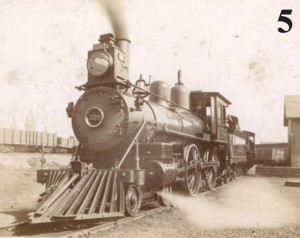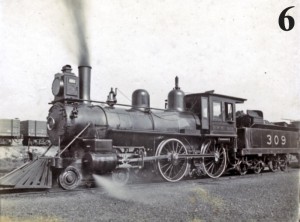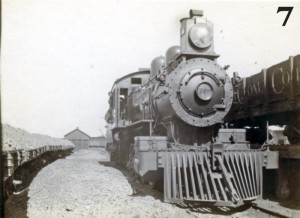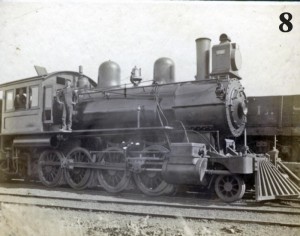Part 2 of 4: Valuable Donation to Toronto Railway Museum
Image #5 below and the three that follow were taken around John Street. The captions contain just locomotive numbers and it is only possible to determine the location by a detail in this image. On the far left one can barely make out the three towers of Union Station. CPR No. 309 is a 4-4-0 American built in 1887 by CP’s New Shops in Montreal. It was renumbered 269 in 1907, then No. 179 in 1913; it was scrapped in 1927. The locomotive appears to be double-headed with another engine behind it. By the 1890’s, more powerful 4-6-0 locomotives were being used to haul longer and heavier passenger trains, and 4-4-0’s were frequently double-headed when used in mainline service. Just to the right of the second engine’s cab, one can see the CPR freight shed that extended west from Simcoe Street.
Image #6 was taken at the same time as the previous photo from a slightly different angle. The caption indicates that the locomotive was assigned to the “TH&B division.” Passenger service over the Toronto, Hamilton & Buffalo began in 1897, the same year that the first John Street roundhouse was built. These images would have been taken just east of the roundhouse.
Image #7 and the following image appear to have been taken at the same time as the previous two. CPR No. 745 was a 2-8-0 Consolidation built by New Shops in 1899. The locomotive was renumbered 1044 in 1902, which enables us to more precisely pinpoint the date. Renumbered again to 1414 in 1906, and 3214 in 1913, the locomotive was scrapped in 1946. On the left of the cab can be seen what appears to be a portion of the first roundhouse.
Image #8 is another angle of No. 745, which was not a passenger locomotive assigned to John Street and appears to be engaged in some sort of grade work east of the roundhouse. The facilities were constantly improved and expanded at this time, including the building of two huge new freight sheds that extended from the turntable to well past Simcoe Street. Michael advises that No. 745 was a compound locomotive, as evidenced by the larger slide-valve steam chest on the left side. The bulge in the boiler jacket clearly indicates the presence of a Belpair type firebox. These were typical of modern British practice giving as they did larger combustion and steam spaces above a narrow between-the-frames grate. This design enabled expanding steam to be utilized in more than one set of cylinders.
Image #9 has no caption but a copy of this photograph was acquired by the late Omer Lavallee and appears in his book Canadian Pacific Steam Locomotives. It shows engineman H. Flood in the cab of 4-4-0 No. 306 around 1900. An interesting detail is the shelf on the backhead used to keep Flood’s oiling can and teapot warm, or so I thought. Michael Guy indicates that isn’t his tea pot on the shelf although it may have started life as one. The long spout can is for oiling around the motion, the “teapot” style holds heavy cylinder oil for use in the ubiquitous cylinder sight-glass displacement lubricators of the period. The oil poured more easily when warm hence the shelf to keep it both warm and handy since the lubricator was mounted in the cab. Actually, the oval shape, long steep spout, the large lid and flat handle of this one all suggest it is in fact a purpose made oil can. Another detail not apparent in Lavallee’s book but shown here is seen through the cab window. This is the John Street bridge over the rail corridor, built in 1897 and demolished in the 1920’s.
Click on each image below for a closer look!
Click here to read the next posting in this series of 4.
Posting by Derek Boles, TRHA Historian






